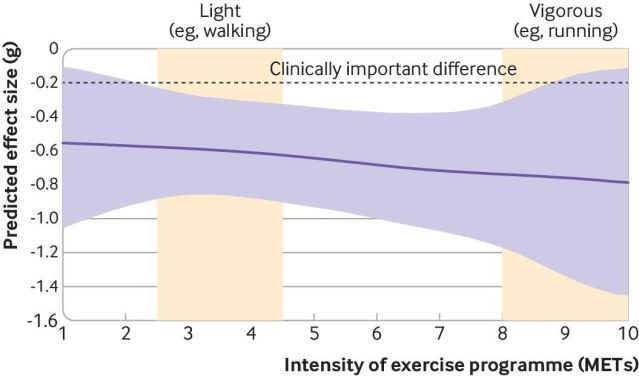Depression
Vigorous Workouts Alleviate Depression Better Than Easy Ones
Walking is an effective drug-free antidepressant—jogging is even better.
Posted February 21, 2024 Reviewed by Kaja Perina
Key points
- A meta-analysis of 218 studies examined the effectiveness of exercise for the treatment of depression.
- This meta-analysis found that exercise reduces depressive symptoms better than pharmaceutical antidepressants.
- When using exercise to alleviate depression, there's a dose–response: Harder workouts are more effective.
- Combining physical activity with selective serotonin reuptake inhibitors enhances SSRIs' efficacy.

Over the past two decades, countless studies have shown that physical activity helps to offset depression risk and can alleviate depressive symptoms. But what's the optimal "dose" (intensity/duration) and best type of exercise (cardio, weightlifting, yoga, etc.) when prescribing physical activity for the treatment of depression?
A recently published systematic review and meta-analysis (Noetel et al., 2024) of 218 randomized controlled trials identifies which modalities of exercise work best for the treatment of depression and pinpoints how the intensity of someone's aerobic workouts (walking vs. running) influences exercise's ability to combat depression.
Cardio, Weightlifting, or Yoga Can Help Alleviate Depression
This meta-analysis found that walking or jogging/running, strength training, and yoga were well-tolerated by most people and that, in general, these exercise modalities were superior to pharmaceutical antidepressants when used as a standalone treatment for mild or moderate depression. The researchers also identified a dose–response based on exercise intensity: strenuous workouts reduced depressive symptoms more than easier workouts.
As the authors explain, "Exercise is an effective treatment for depression, with walking or jogging, yoga, and strength training more effective than other exercises, particularly when intense." For example, as the chart below illustrates, walking is good for treating depression, but jogging or running is better.

What's the difference between jogging and running? On a treadmill, walking speeds are typically below 4 miles per hour (mph), jogging occurs between 4-6 mph, and running is considered any speed above 6 mph. Notably, the speed difference between walking, jogging, or running isn't set in stone; these are loose guidelines that can be used as ballpark estimates to gauge what constitutes a "vigorous" workout.
METs (metabolic equivalent of tasks) are another way exercise physiologists measure energy expenditure and intensity during physical activity, but precisely measuring METs is difficult outside an exercise lab. In general, for the average person, sitting in a chair uses about one MET per minute, walking at 3.5 mph uses 4.3 METs per minute, and running 6 mph uses 9.8 METs per minute.
The transitory threshold between moderate and vigorous exercise on a treadmill usually occurs just above 4 mph as someone walking transitions to jogging. At a 4.4 mph jog, the average person uses 6 METs.
How METs Reflect Exercise Intensity and Energy Expenditure
- 1 MET = Energy Used Sitting at Rest
- 1.5-3 METs = Easy Intensity Exercise
- 3-6 METs = Moderate Intensity Exercise
- 6+ METs = Vigorous Intensity Exercise
Increasing intensity during strength training and yoga exercises also boosts these activities' depression-alleviating effectiveness. For example, "light" chair yoga will help with depressive symptoms. But a vigorous vinyasa "flow yoga" session with continuous movements from one pose to another has more robust anti-depressant effects.
Similarly, a full-body strength training session that completely exhausts major muscle groups would alleviate depression more effectively than a less intense resistance training session that doesn't make muscles "burn."
Creating a weekly routine involving cardio, weightlifting, and some yoga seems ideal. Mixing up your workout routine to include 75-150 minutes of vigorous cardio plus two full-body strength training sessions per week meets the World Health Organization's recommended physical activity guidelines for overall well-being and can also be part of a winning formula for combating depression.
Warning: Increasing exercise intensity increases the risk of injury or burnout. Always consult with a healthcare provider before kickstarting a new workout regimen that involves strenuous physical activity, especially if you haven't been doing vigorous exercise regularly.
Being a "weekend warrior" who bites off more than you can chew in terms of being overzealous about working out vigorously after months or years of sedentarism is likely to backfire by causing injury or a medical emergency. If your physical fitness level is low, gradually work up to more intense workouts.
Combining Exercise With SSRIs Enhances Antidepressant Effects
Another significant finding of Noetel et al.'s meta-analysis on how physical activity affects depression is that combining exercise with conventional treatments such as selective serotonin reuptake inhibitors (SSRIs) increases the efficacy of these pharmaceutical antidepressants when treating major depressive disorders.
As Juan Ángel Bellón explains in an accompanying BMJ editorial, "The effect of exercise appeared superior to antidepressants, although when exercise was combined with antidepressants, the effect of the drugs improved."
Take-Home Message
When using exercise to treat depression, there's a dose–response: vigorous exercise is more effective than easier workouts. That said, even low-intensity exercise such as casual walking, easy resistance training, or "light" yoga can help alleviate depressive symptoms and confer meaningful benefits.
Bellón sums up the clinical significance of the latest (2024) network meta-analysis of randomized controlled trials on the effect of exercise for the treatment of depression: "Primary care clinicians can now recommend exercise, psychotherapy, or antidepressants as standalone alternatives for adults with mild or moderate depression. The final choice depends on patient preference and other considerations, including any barriers to access."
References
Michael Noetel, Taren Sanders, Daniel Gallardo-Gómez, Paul Taylor, Borja del Pozo Cruz, Daniel van den Hoek, Jordan J Smith, John Mahoney, Jemima Spathis, Mark Moresi, Rebecca Pagano, Lisa Pagano, Roberta Vasconcellos, Hugh Arnott, Benjamin Varley, Philip Parker, Stuart Biddle, Chris Lonsdale. "Effect of Exercise for Depression: Systematic Review and Network Meta-Analysis of Randomised Controlled Trials." BMJ (First published: February 14, 2024) DOI: 10.1136/bmj-2023-075847
Accompanying editorial by Juan Ángel Bellón. "Exercise for the Treatment of Depression." BMJ (First published: February 14, 2024) DOI: 10.1136/bmj.q320




